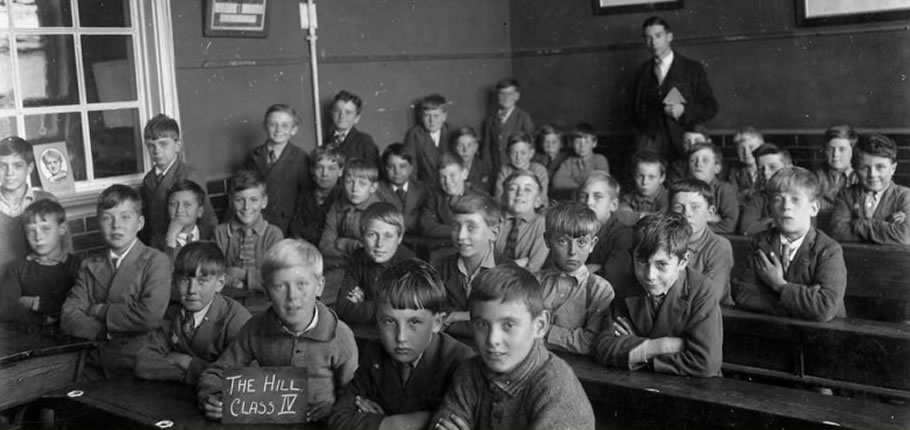
The Schools
School life 100 years ago was similar in a lot of ways to what we have now. Classes involved reading, writing and arithmetic and there were also physical education lessons. Girls were generally taught sewing and needlework. In addition to their normal lessons, young people also usually attended Sunday school for religious education. School’s everyday life all those years ago was always different in many ways then now.
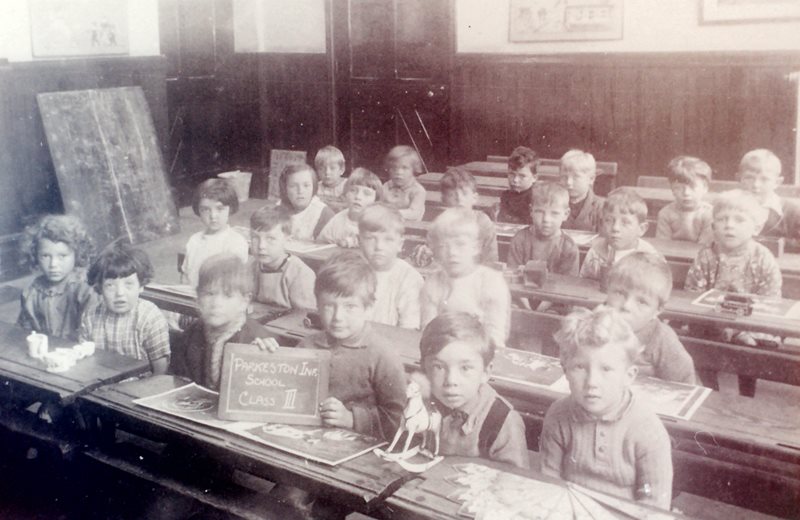
Parkeston Infants
Back then it was the opposite, many were lucky to go to school and loved it because it was either school, or work. school clothes, teachers, rooms, learning and homework always had a stricter and harder life. Afterschool there were many jobs children had to do at home plus the ‘Homework’. like cleaning up helping there fathers, then having to do homework. lunches were different too because most families would have to grow their own food and many rich people had the money to buy some food.
By 1880 many new schools had been set up by the education boards. This made it possible for the 1880 Education act to make school attendance compulsory for all children up to the age of ten.
The Harwich school board was formed on 25th November 1892 and abandoned 30th September 1903 when schools came under the control of the council by way of an education committee.
Under the 1918 education act School became obligatory for all Children up to the age of 14.
Harwich Corporation School or Free School
The first proper school in Harwich was the Humphrey Parsons School in Kings Quay Street (also known as the Corporation School and also the Free School).
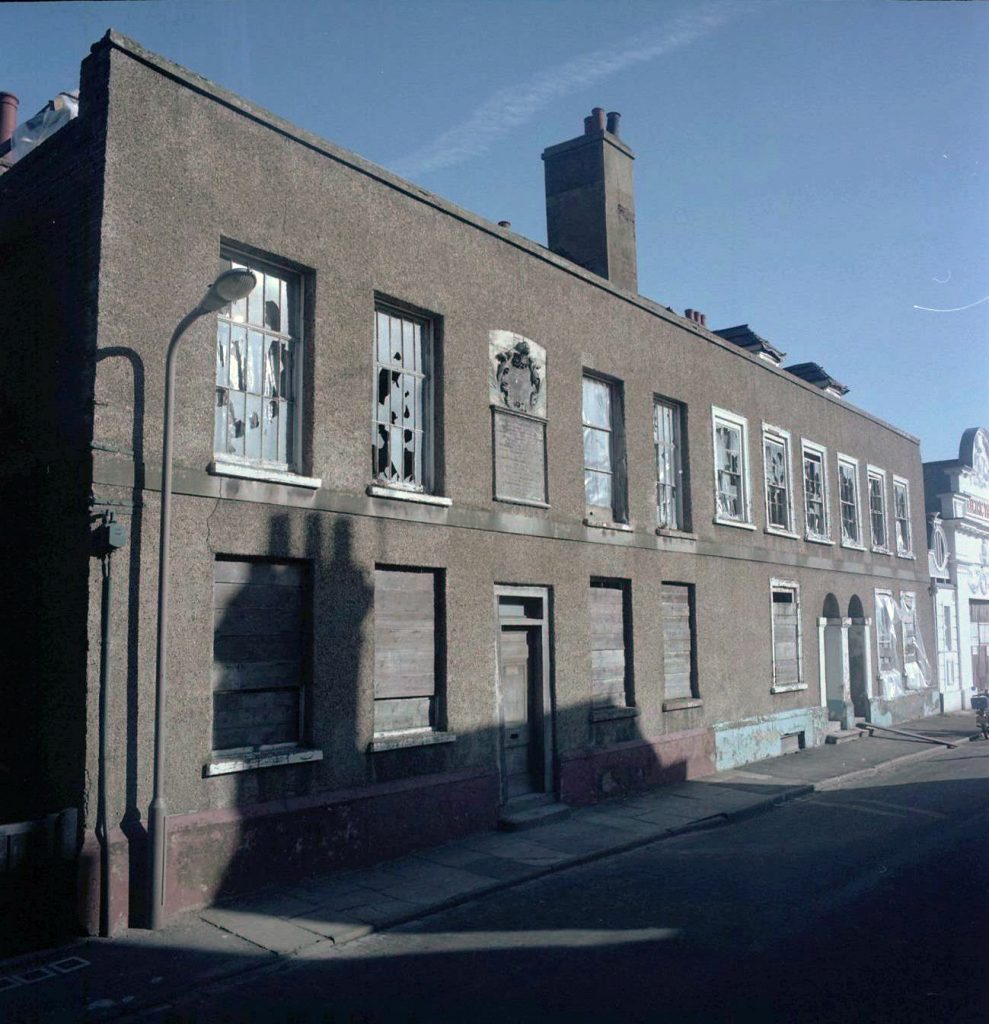
Harwich Corporation School
Built by Sir Humphrey Parsons in 1724 there were thirty two boys, admitted at the age of eight and remaining at the school until they were fourteen, at a cost of £7. 10s. per annum to educate 8 boys. The corporation of Harwich increased the salary to £40 a year, out of their own funds, and added 24 boys to the free establishment. The corporation are the patrons, and the school and house were uniformly given to the curate of Harwich, in aid of his curacy, but very recently the corporation have given it to a non-resident clergyman, who conducts it by a lay assistant, and the curate is consequently distressed for a house.
In 1855 the name was changed to the Harwich Corporation School when Harwich High School was opened but was later used as an annexe to the Harwich Further Education Centre. It was restored in 1981 from a derelict condition, as a dwelling house, now called ‘School House’.
Schooldays
My memory goes back to my schoolboy days when, at the Corporation School, schoolmaster Helsden and his satellites, with much patience and perseverance, endeavoured to inject into our sluggish and unresponsive brains the three “Rs” those fundamentals of education so much in evidence during the Victorian era. But there was another “R” which had a greater claim on our interest – Romance.
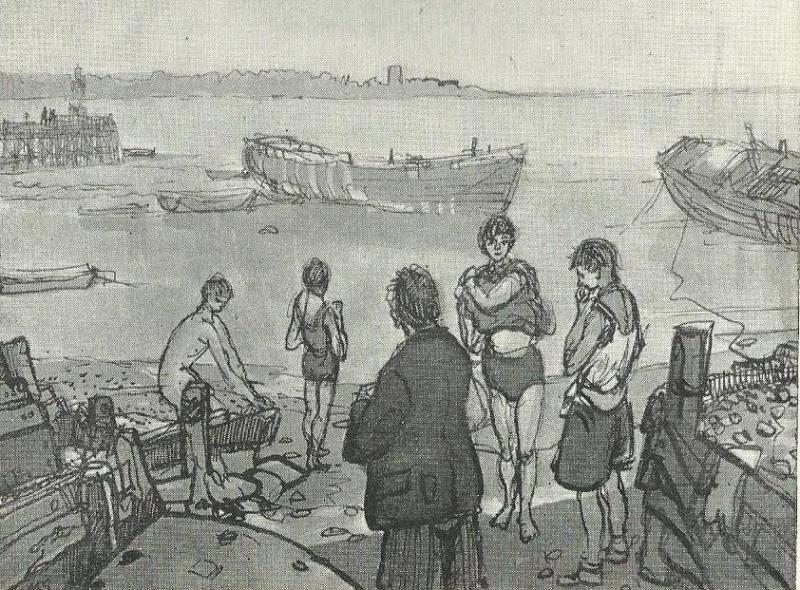
School days
And in the summer days, when the school gates were opened and we were at last released from the torment of studies and the stuffy atmosphere of a diminutive classroom, a herd of romantic youths, with the spirit of adventure in their souls, would rush out and proceed helter-skelter to what we called the “wrecks”.
Down near Vaux’s shipyard were the hulls of three old wrecks. One, the “Inverness”, a schooner, had been converted into an improvised pier and bore very little resemblance to a ship. For stout planks had been fastened and immovable. Some distance away were two other hulls, both of full-rigged ships, which had been dismantled of all their gear and were slowly losing their identity by the ravishing power of the sea. Their names, still visible on stern and bows, proclaimed them to have been the “Albatross” and the “Alpha”. No doubt, in their prime of their youth, they had been lovely to look upon, but had now, through infirmity and old age or through being mishandled by incompetent men- ceased to be of further service to mankind and had come to finish their declining years in the quiet waters of Harwich harbour.
In 1979 Betty Holbrook began to take interest in the restoration of old houses in Harwich, It began with a suggestion from her husband, that she should buy a two-bedroomed bungalow, Instead she bought what she refers to as ‘half a street’, numbers 42,44 and 45 King’s Quay Street, then roofless, and proceeded to restore the building so well that she was given a Civic Trust Award.
St Josephs Roman Catholic School
Built in 1845 on the site which adjoined the Roman Catholic Church near the corner of main road and Station road, Harwich.
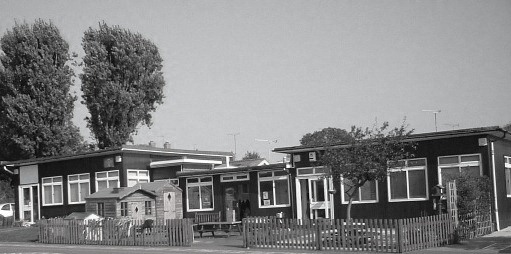
St Josephs Roman Catholic School
The superstructure is in Derwent prefabricated timber construction with a detached boiler house, fuel store and sewage and pump house in brick construction with concrete roof. The School was constructed as a 3 class school for 70 pupils, an additonal classroom and storage was added which converted the school catering for 120 pupils.
In June 1940 St Joseph’s School was closed and the children evacuated to Gloucestershire,when the school reopened, the Nuns from the Convent took over the running of the School. The School was so badly damaged in floods of 1953 that it was unsuitable and the pupils were accommodated in the tower an annex of The Harwich County High School until new premises were built at the Drive which was opened on the 14th September 1955.
Saint Joseph’s is a small, family-orientated Church Primary School and is still teaching children today.
The Central School
Opened on the 29th of august 1887 the school in Waddesdon Road could accommodate two hundred boys and infants.
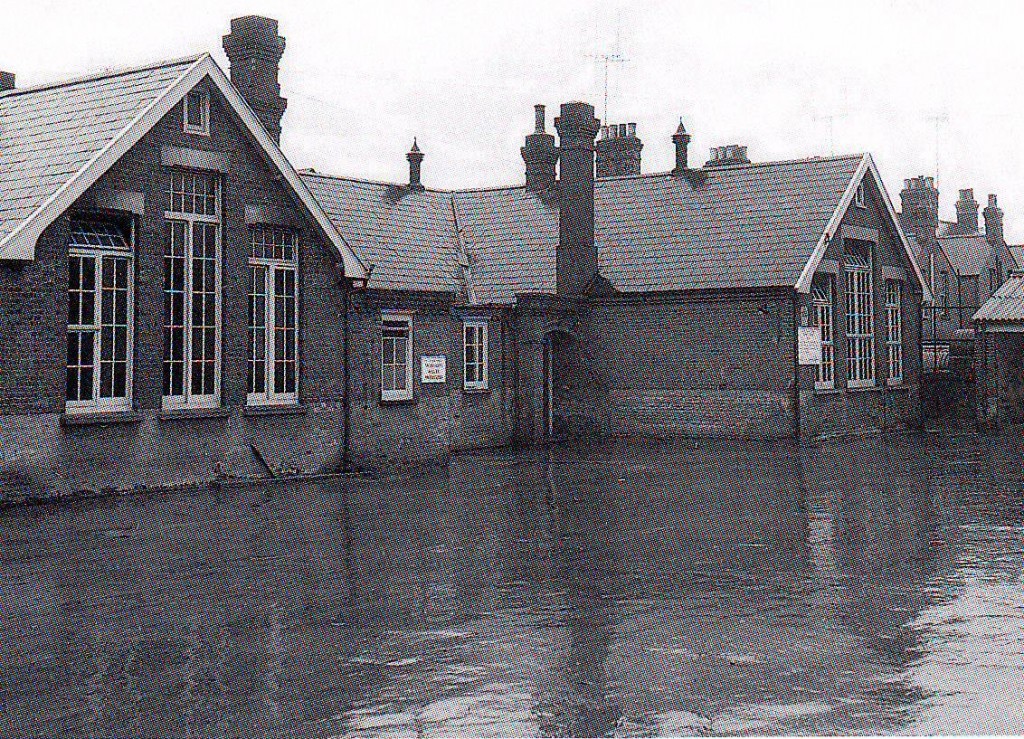
Central School
It had two classrooms, one for the elementary boys and the other for infants. On its first day 48 boys and 28 infants attended. Major changes took place from the 1st of April 1922 when school where divided into three, infants, primary and secondary. Central school now became a secondary school for boys. The central school closed on the 31st July 1946 and the premises were adapted for use as a County Library in 1947.
Parkeston County Primary
Parkeston School was built by the Ramsey School Board and opened on the 4th October 1888 at the top of Hamilton Road at a cost of £2,190.
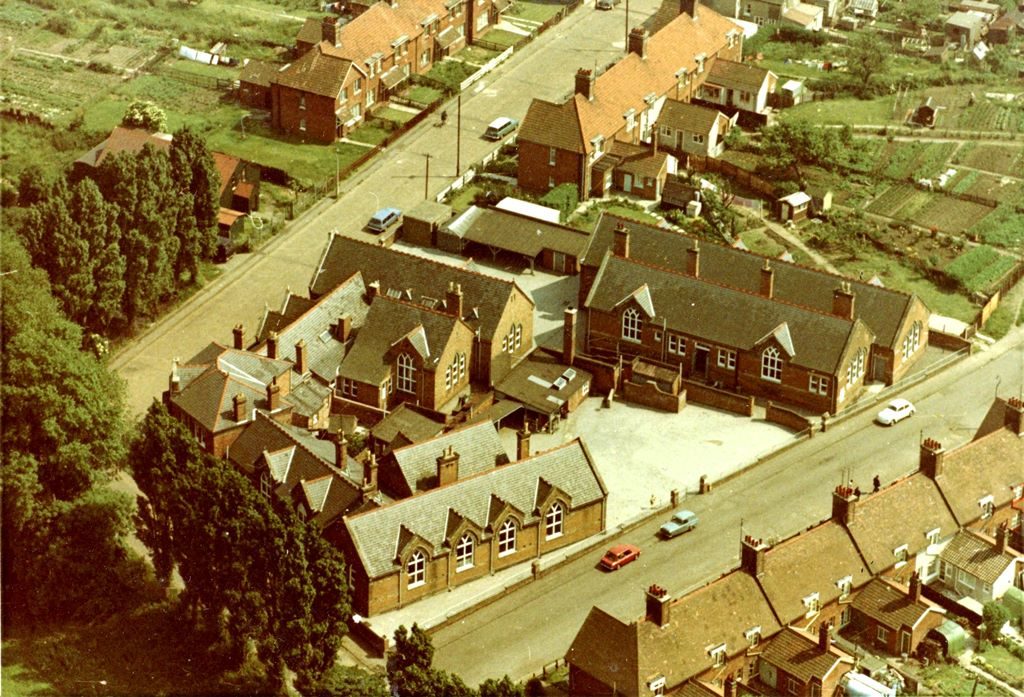
Parkeston County Primary
Parents had to pay until 1891 so attendance in the first couple of years would have been patchy. The capacity was 200 plus 178 infants. The school was divided into three separate units, mixed infants, boys elementary and girls elementary. The first day of opening admitted 42 boys and 41 girls.
St. George’s School (Upper Dovercourt Board School)
The first purpose build school was the Upper Dovercourt Board School for infants, later known as St George’s School. Built by local builder Edward Saunders at a cost of £1,277 and opened on the 15th of October 1894.
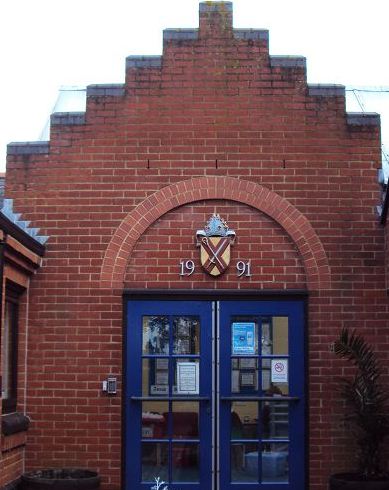
St. George’s
The school was designed to take a maximum of 185 children. After 1902 became upper Dovercourt Council School, by 1946 had become a County Junior school for 7-11 years olds. In 1957 the school was renamed Upper Dovercourt St George’s County Junior School, The school finally closed in July 1969 with the opening of Chase Lane County Primary School. St George’s school annexe was no longer required. The building was taken over to become The new All Saints Church of England School in 1982.
Lower Dovercourt Infants (Second Avenue Infants)
Lower Dovercourt infants was opened in 1895 as a board school,with just 24 pupils, lessons were given on obedience and politeness and setting the tea table as well as in reading ,writing and arithmetic.
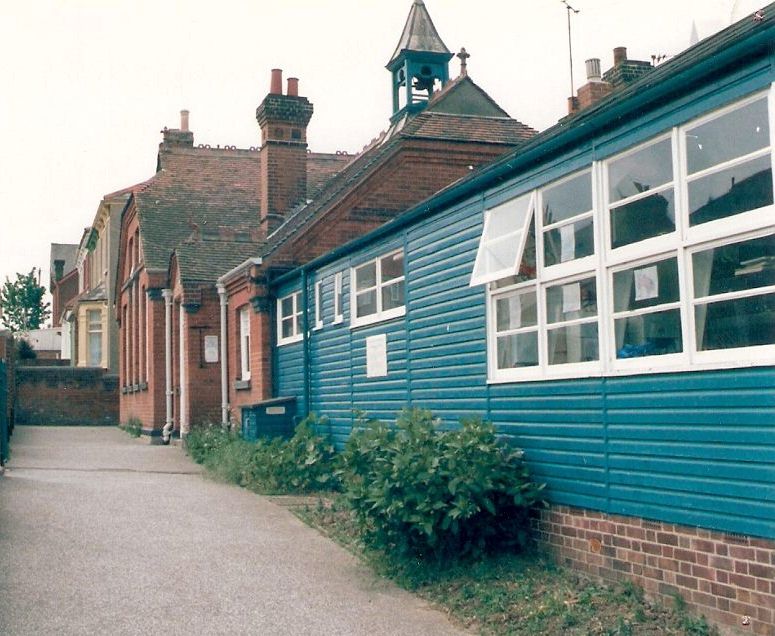
Second Avenue Infants
Built by local builder Edward Saunders at a cost of £ 1,477. There were two classrooms, one large and one small with the larger room being divided by a curtain. from 1902 became council school, also known as Second Avenue infants, the school closed on the 2nd august 1939 but with war imminent did not reopen unit 7th December that year.
From 1957 the school was renamed Lower Dovercourt County Infant’s School. the School amalgamated with Mayflower school and finally closed its doors on July 18th 1986. The site is now housing.
Bathside County Primary School
Opened in 1896 as a Board school for girls & infants, the school was built by Ipswich builders Smith, Beaumont & Dawson at a cost of £3,319 including toilets. The school was designed to take 240 mixed infants and 150 elementary girls. Mr Round M. P. officially opened the school on the 9th of September 1896. From the 1st September 1947 the school became an county infant school until its closure in 1983.
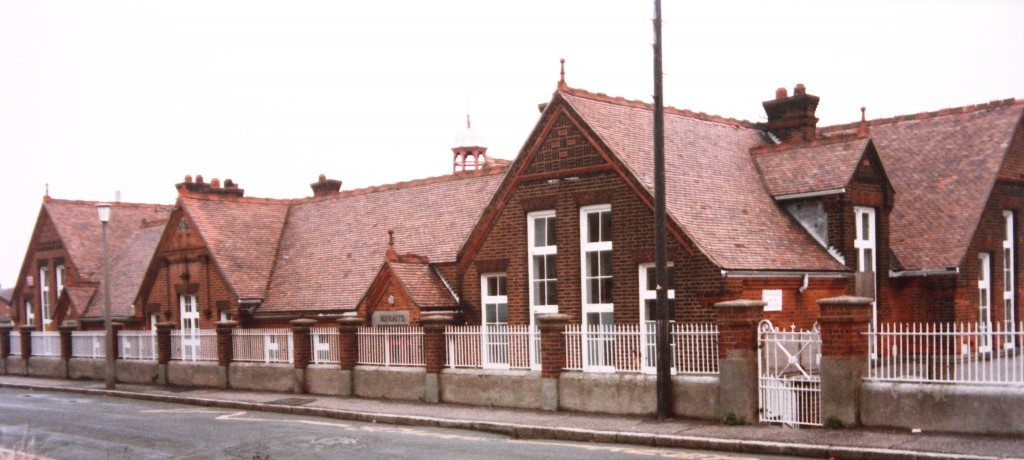
Bathside School
One former pupil recalls: “I went to Bathside School and still remember the time Mrs Green pulled me out of the assembly by my ponytail and I remember the caretaker who used to give out rich tea biscuits if we didn’t win on sports day. I think he was called Mr Harrison and Mrs Fisher was a playground monitor. I loved going to that school”.
Harwich County Primary
The Main Road School opened on the 9th September 1896, it and the Bathside School, opened in the same year and was for girls and infants only, and boys were not admitted to the Main Road School until 1950.
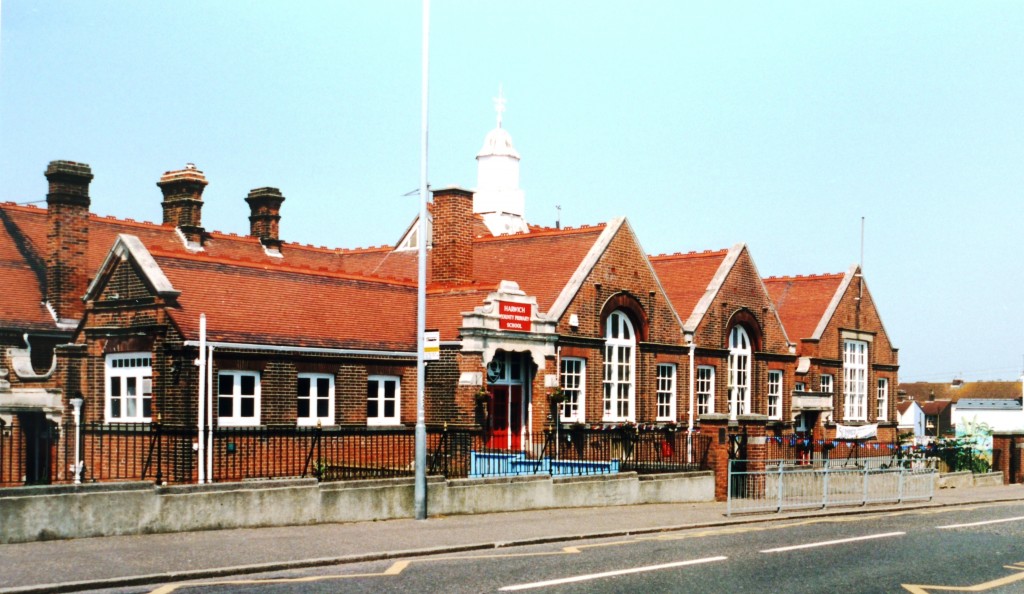
Harwich County Primary
The school was built by Edward Saunders and the architect was Mr J W Start of Colchester, it was described as ‘an elegant and well-built structure of local red brick, with bath-stone dressings. In its time the school had its share of disruption, during the last war pupils were evacuated on 1st June 1940, and the building was used for military purposes, and then in 1953 the basement was damaged by floods. On the first floor were three class-rooms, accommodation was for 240, being 22ft by 48ft, 22ft 24ft, and 22ft by 43 ft. respectively. On the left of the same floor there were two class-rooms for infants, accommodation being provided for 218 making a total accommodation for 458 children. On the ground floor was a cookery class-room, cloak rooms, teachers room, lavatories and covered-in playgrounds. The floors were fire proof faced with pitch pine blocks, while the rooms have matchboard dados.
The School celebrated its first hundred years in 1996 with a Victorian Fair and Pageant. In the playground pupils displayed their excellence in numerous sports, including Indian club swinging, horseshoe throwing, bench swimming, and skipping, and the girls demonstrated their deportment carrying books on their head. Afterwards there was a party for all in the playground, and every child received a centenary mug. The school finally closed in 2003.
In May 2008 a fire tore through the Victorian building leaving the building a charred wreck. Work to transform the run down former Harwich Primary School site into 39 flats is believed to start at the end of 2012.
Esplanade School
In 1855 Rev R. Bull the incumbent, applied for and was granted aid to rebuild the school, with separate departments for boys and girls, and with the teachers house in the Tudor style at a cost of £615. Wednesday November 28th 1859 is given as the official re-opening day of the school. The school rooms having been enlarged, were reopened on Wednesday evening with a concert of sacred music kindly given by Mr James Godall of Ipswich in aid of funds. During 1907 the school was enlarged to cater for mixed infants, girls elementary and boys elementary in three separate units. Whilst building work was underway, when the extensions where complete the school became known as Esplanade School.
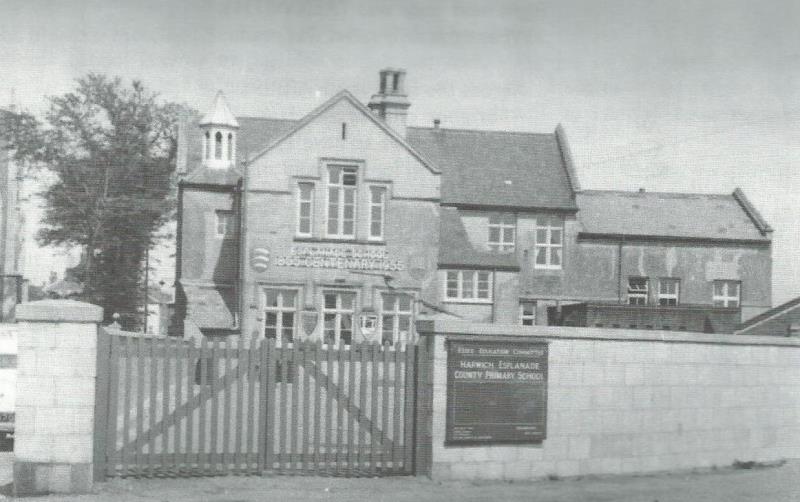
Esplanade School
To anyone who has never heard of Esplanade School, it stood on its triangular plot, like a ship with bows sailing towards the Green and beyond. Built originally as a single storey building in the early 19th century, it was demolished and rebuilt with two storeys in 1857. It was 1907 when the School was first known as the Esplanade School, previously being referred to as the National School.
The interiors of both the senior and infant schools were Spartan – bare wooden floors, inconsiderately placed fires and several classes to each of the large rooms, seated at small wooden desks. At times it was so cold that lessons were interrupted by the teacher getting the children to stand and do arm swinging exercises to warm them up. The school could take 266 pupils but almost always had many more – sometimes 100 more. With no hot water at this time either, just 2 cold taps and basins.
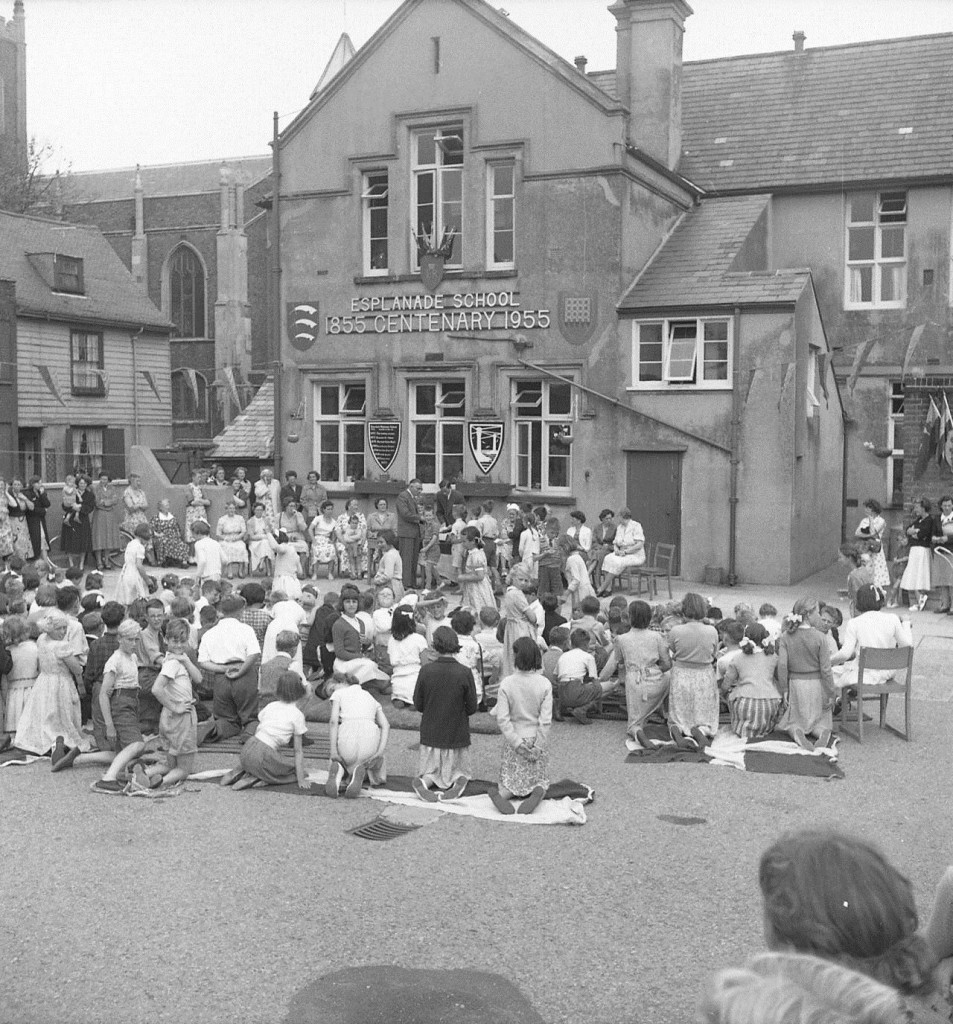
Esplanade School
War was declared in September 1939, and the school was re-opened on the 19th of October, allowing time for air raid shelters to be erected. From 1st September 1947 Esplanade School catered for mixed primary children and infants were transferred to Bathside School. On 1st June 1940 all the borough schools were evacuated and special trains left Harwich for Wales and Gloucestershire between 8am and 9am. In 1945 alterations were made to the dining hall, kitchen and staff room and the infants department, which was used as a war time clothing store. Following the new education act of 1944 the local authority ceased to exist the school was taken over by the Essex education committee and became a junior school for boys. a school badge, portraying the high and low lighthouse was adopted.
A parent – teacher association was formed in October, with over 300 parents and friends attending the school Xmas concert in the Quay Pavilion.
Punishments
One of the mothers came and canned a boy in the school for taunting. One of the boys was sent to prison for 14 days for stealing a box of ointment out of a beans shop.
Floods
February 1953 the great flood disaster which came so suddenly in the night and of which such bitter memories are still with us, The scene of the school on the Sunday morning following the flood Was one of heart breaking destruction and desolation. Great heaps of rubbish and debris were piled high in the yard, water still swirled sluggishly through many of the classrooms, with a miscellany of Books, papers, and general school equipment floating around in the dirty grey water.
Many Harwich families found sanctuary at the transit camp at Dovercourt and it took a few days to restore some sort of order from the chaotic conditions. Following an emergency meeting of all school staffs, the school was opened in the education hut at the camp with about a dozen children and a few infants. Numbers grew, and soon transferred to other huts Belonging to the Chafford School. A new home was found at at Parkeston School until the close of the summer term.
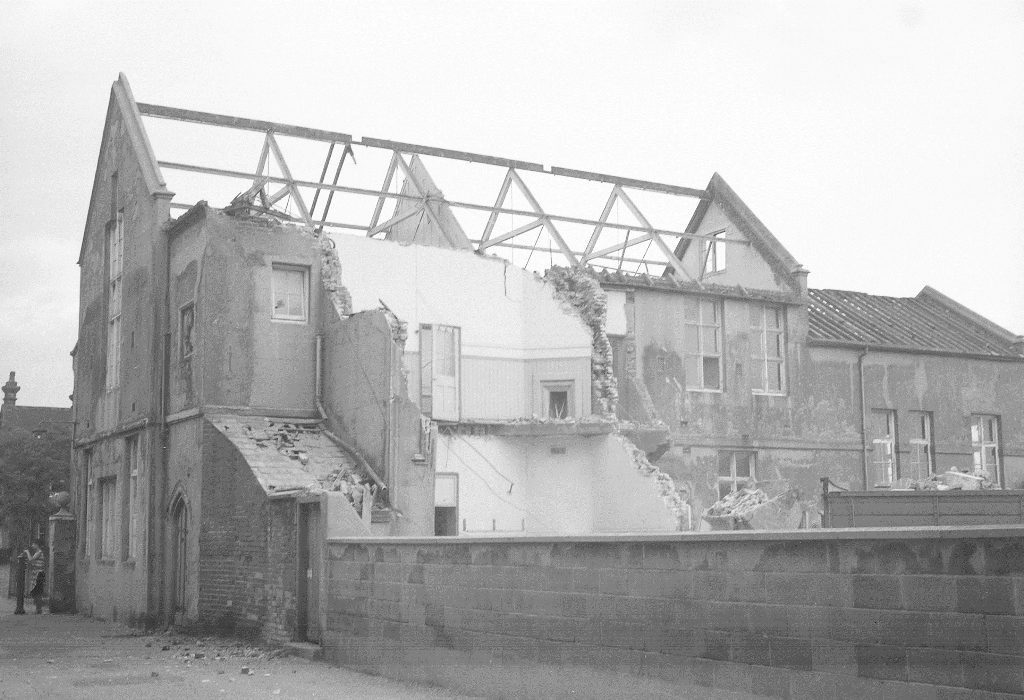
Demolished 1968
The children returned to the esplanade school after the summer holidays and found to their delight, shining block floors, in place of the old worn boards with their protruding nail heads, and a school restored, and working smoothly and happily. In 1957 the Esplanade School moved to the Main Road School premises and became Known as Harwich County Primary School, the Esplanade School was used as a slipper factory for a few years but during the summer of 1968 the main building was demolished to make way for esplanade court.
The Esplanade has had many changes of fortune over the years, passed through fire and flood, but stands as a monument to the educational life of the borough, in the shadow of the Church which saw its creation, and close to the sea, which has called so many of its scholars to serve.
Convent School
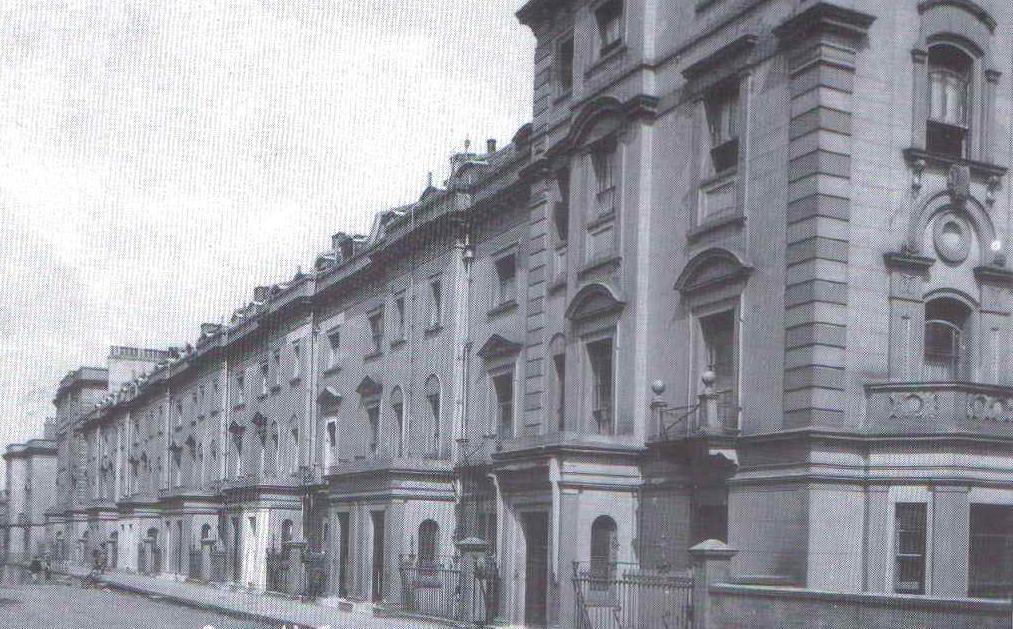
Dovercourt Convent
The Dominican sisters ran a convent School at Banksea House at the end of Orwell terrace. The sister of Our Lady Mary help for Christians took over the property in July 1932 and re-opened the school for girls only. The playground contained a victorian greenhouse where the nuns grew grapes, which they sold for a penny per bunch. In 1940 the military took over the house for the duration of the war and the nuns Briefly returned to Banksea House.
The building was finally vacated at the end of 1953, serious cracks appeared in the in the walls and the building colapsed on the 29th of October 1994 into a heap of rubble. a couple of weeks before the collapse and structural experts were brought in, but too late to save the building. Tendring District council anticipated that it would be eventually rebuilt to the same exterior design to reinstate the appearance of the terrace.
Will we live long enough to see it re-emerge like that?
Harwich County High School
Government legislation necessitated the search of a suitable site to build a secondary school in Harwich. The search began in 1907 with £ 9,000 available for the purchase of site and building.
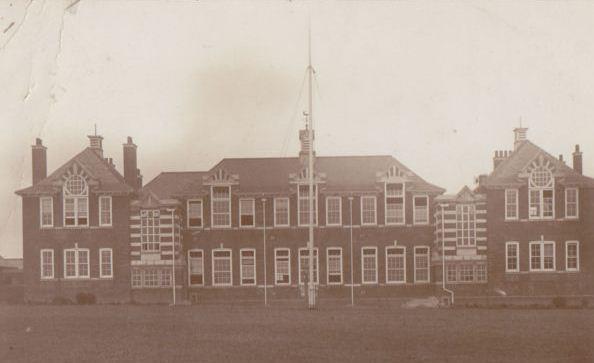
Harwich County High
The foundation stone was laid on July 14th 1909 on an elevated site near Blue House Farm. It was envisaged that much-needed technical classes would be held there in the evenings. It was the town’s first Grammar School, before that the children were sent “away” to be academically educated. It was very advanced in its time, being co-educational. It opened in 1910 with seven staff and less than a hundred pupils. There were about ten “scholarship” pupils, and the balance paid fees (3 guineas per term), but all pupils had to buy their books.
The Harwich County High School was opened on April 27th 1910 by the Chairman of the Essex Education Committee; E.N.Buxton. standing in 10 acres of playing fields the new school boasted an assembly hall, gymnasium 6 classrooms, chemical laboratory, cookery Room, workshop and library. The Towers would be used to provide overflow accommodation in the future). The school hours were 8.55-12.30 and 1.55-4.30 and termly fees were 3 guineas. School dinners were just 6d. initially the School could accommodate 136 ‘scholars’ under the Headship of James Valentine.
“Prep”, compulsory for all, commenced at 5.40pm each evening and school continued on Saturday morning. Pupils were delighted when First World War blackout requirements terminated evening prep. For being late, or boys not lifting their caps on meeting a member of staff, or girls not wearing gloves when walking out, or laughing unbecomingly, warranted detention. Detention class was held on Saturday afternoon. Boys of the detention class opted to level the cricket pitch were known affectionately as the “Chain Gang”.
There were three houses, Nelson, Wellington, and Queen Bess. Each had its own House Day, Nelson on Trafalgar Day (Oct 21st), Wellington on Waterloo Day (June 15th), and Queen Bess on Empire Day (May 24th). Traditionally these were the days when former pupils returned to the school and special teas were organised.
After Sixty Four Glorious years the school lost it’s identify when it became merged into the Harwich School in 1974.
Today it is known as the Mayflower School which transferred from the old Mayflower School in 1987.
The County High School (Tower School)
A new school was built between Main Road and the Stour. The County High school (Tower School) opened on the 27th April 1910.
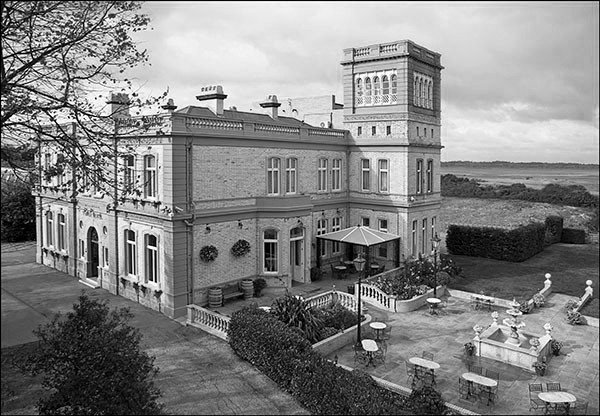
The Towers
The school had six classrooms with chemical labs, cookery rooms, a dining room and gymnasium. The Tower had been built as a private residence for local businessman John Robson Patrick in 1855. With forty boys and girls. As the number of people neared three hundred the tower was taken over to accommodate a preparatory department and junior school and remained in use until 1971.
The Hill School
By virtue of the drastic order of the Board of Education, in the closing of the Harwich Corporation School, and the Lower Dovercourt Church of England Schools, it was incumbent upon the local Board of Education to provide further School accommodation, therefore a new school to educate some 250 each of boys and girls has been built at Upper Dovercourt, and on Monday, a considerable gathering of townspeople assembled to witness his Worship the Mayor (Mr. E. Saunders) publicly open the new schools, which are to be known as the High Schools.
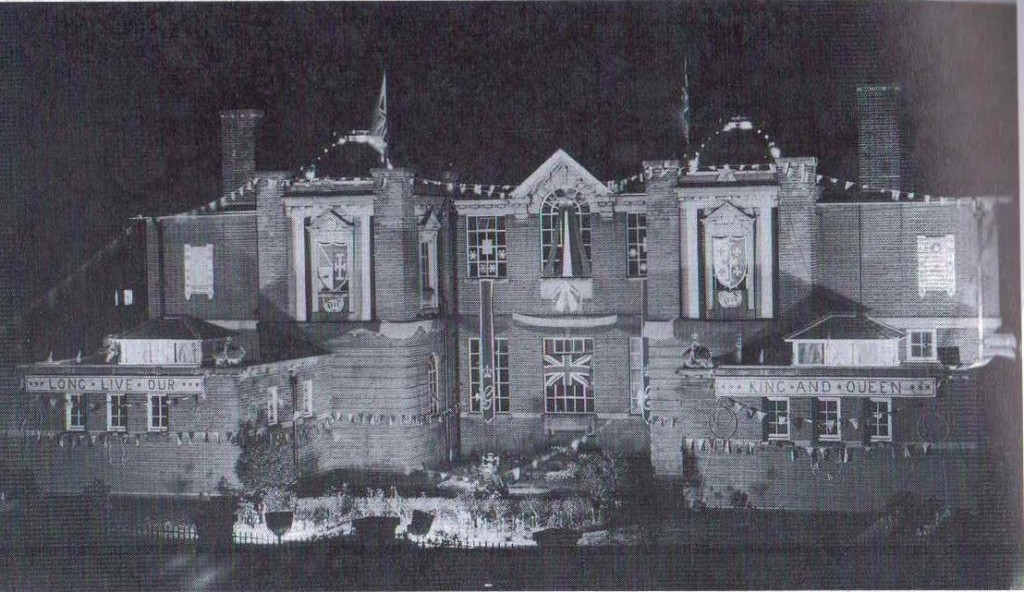
Hill School
The school is of two floors of six-class rooms to each. Which are entered from a marching corridor 52 feet long by 16 feet wide. The ground floor is for girls, and will accommodate 250 pupils in classes ranging in number from 36 to 50. The first floor is arranged on exactly a similar plan for 250 boys.
Of the two bold towers, which form a principal feature of the front elevation, the western one contains the staircase for access to the Boy’s School and the other cloak-rooms for the accommodation of the heating tanks, etc.
The floors are of fireproof construction, and between the floor and the ceiling of the class-rooms in an air space in order to assist cutting of the sound from the rooms above.
The class-rooms and marching corridors are floored with pitch-pine blocks, and the dados are of glazed bricks. The whole school heated with an accelerated system of low-pressure hot-water, and the rooms are all efficiently ventilated, in addition to having cross ventilation by means of windows in most of the rooms.
In 1902 it became a council School, later the Harwich Main Road County Junior School, and in 1957 it was renamed Mayflower County Primary School. Later in 1957 the school moved from its premises at 66 Main Road to the former Hill school buildings at 363 Main road. It was enlarged in 1986 by an amalgamation with Lower Dovercourt (Second Avenue) Infants’ School.
In 1987 it moved to premises formerly occupied by Harwich County High School, its former premises being converted for use as the Magistrates’ Court. Hill School opened in 1914 at 363 Main Road, Harwich as the Council elementary school for boys and girls up to the age of 14. After the Second World War it became the Secondary Modern school for senior pupils and closed in 1957 when pupils were transferred to the new Sir Anthony Deane Secondary Modern School.
Mayflower County Primary
Formerly the Hill School from 1914 -1957. The school was enlarged in 1986 with Lower Dovercourt (Second Avenue) Infants’ School. In 1987 it moved to premises formerly occupied by Harwich County High School.

Mayflower County Primary
Its former premises in Main Road where converted for use as the Magistrates’ Court, and all pupils were transferred to the new Sir Anthony Deane Secondary Modern School.
The Sir Anthony Deane School
The School, which was named after Sir Anthony Deane, a Naval Architect who was born at Harwich, was formerly known as Dovercourt Hill County Secondary School, and was transferred to the new buildings in March 1957, with 690 boys and girls on roll. The Official opening of the Sir Anthony Deane County Secondary School was by Rear Admiral Walter Evershed on the 19th March, 1958 At 3 p.m.
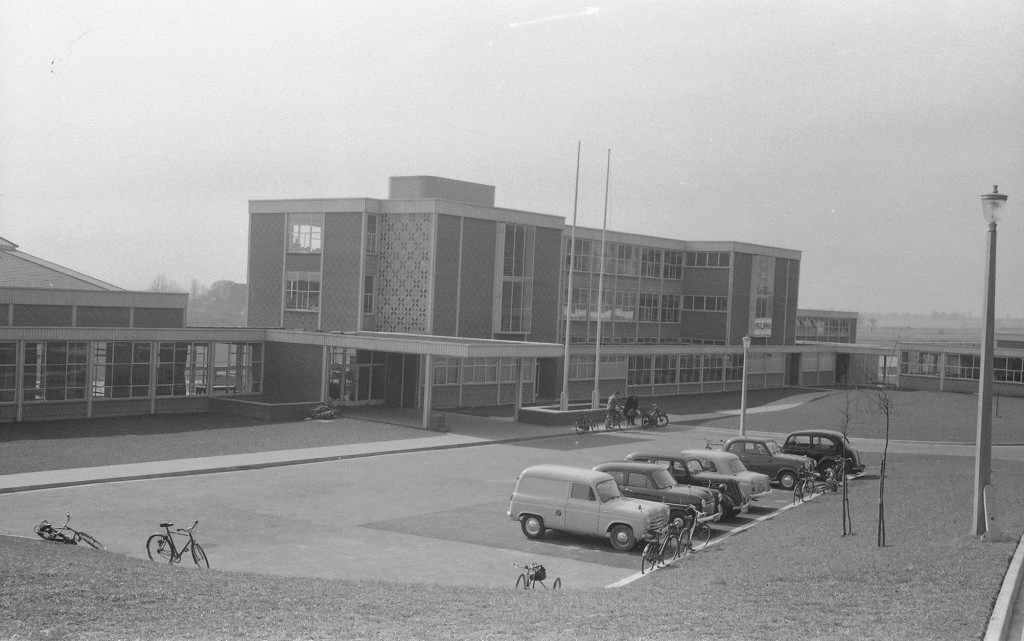
Sir Anthony Deane School
The school buildings, with their playing fields, lie on a slightly sloping site. They consist of a central Three-storey block, containing 14 classrooms, the library and the administration offices. Linked with this block at the eastern end, is a group containing the dining hall, assembly hall, kitchens and boiler house, one gymnasium and changing rooms.
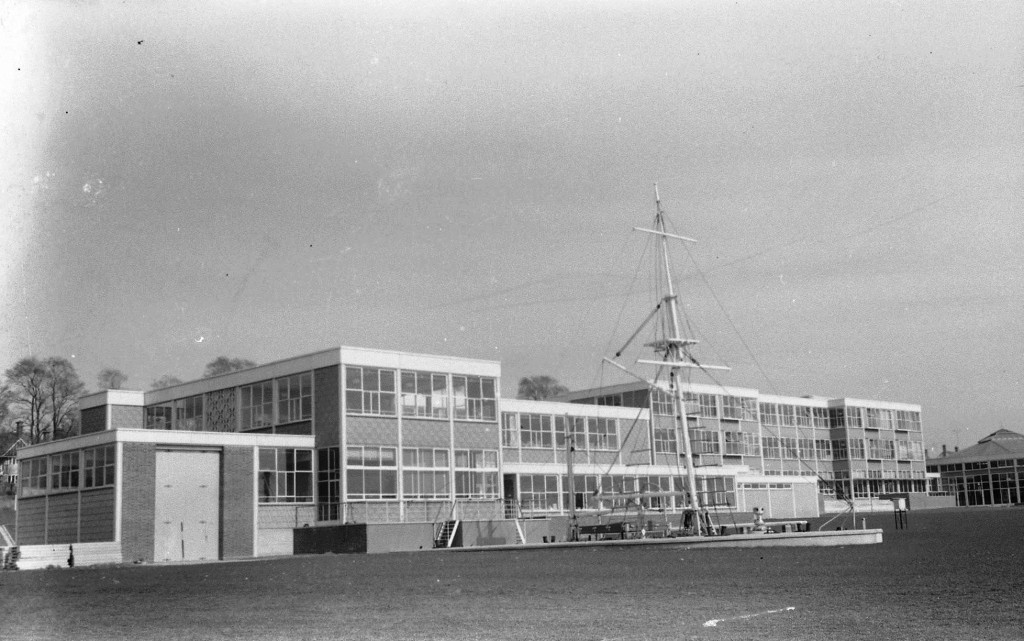
Sir Anthony Deane School
The two-storey wing at the western end of the main block contains classrooms, laboratories, housecraft rooms, and a specially equipped geography and navigation room. outside which is the terrace, equipped as a ship’s deck and bridge, and the school boathouse. The art and crafts room and workshops are in a single-storey wing linked to the main block by a covered way. An interesting feature of the school lies in the facing slabs which form the walls, which are externally composed of pre-cast concrete panels which are patterned and coloured on the face with two different designs and contrasting shades of buff. The two simple repeat patterns have been used to produce a variety of texture, and, with certain sections as pierced panels, to form the staircase windows, in which clear, opaque and coloured glass give a pleasant and novel effect.
The same precast profiled slabs are used internally to form panels in the corridors, where they give a rich decorative effect of a mural.
The staircase balustrades and handrails are made of wrought iron.
The roof of the assembly hall is of slab construction, cast in situ, it is octagonal shape, spanning 50ft, and is supported by eight corner columns.
The entrance hall, foyer and dining hall floors are surfaced with Accotile and Accoflex, Heatherbrown quarry tiles being used throughout the school in circulation routes, with hardwood block floors in all teaching areas, hardwood strip in the hall and gymnasium, and patterned cork tiles in the library and staff rooms.
Work commenced on the site in March 1954, and the school was completed in March 1957, the tender cost amounting to £ 214,256.
The Architects were Messrs’ Johns Slater and Haward.
The Harwich School
September 1974 marked the start of a new era in education in the Harwich area. Old rivalries were forgotten when Harwich High School and the Sir Anthony Deane Secondary School were amalgamated as one under the new comprehensive system to become The Harwich School.
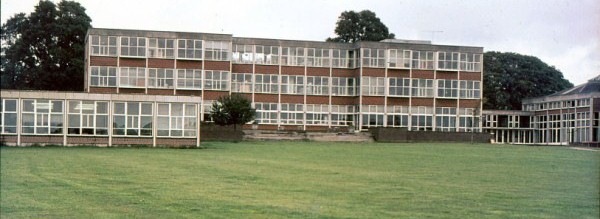
Harwich School
When the Harwich School opened on Tuesday, September 3, 1974, there were 1,490 pupils and 82 teachers. To mark the opening, a new school flag, designed and made by C H Bernard and Son, was handed over to the head teacher and Cyril Moles, chairman of the school governors, by Tom Bernard, the Harwich Company’s managing director, and hoisted rousing cheers from the pupils.
The black, red and white flag bore the Essex county badge, an exact replica of the seal of the Borough of Harwich 1604, when the town gained its charter from King James I.
Boys and girls could follow a course in navigation and seamanship and prepare for life at sea on the fully equipped ship’s deck, bridge and masts which stood on the terrace outside the Navigation room.
The site consisted of four blocks, A-Block classrooms and library, B-Block contained the dining room, kitchen, assembly hall With stage, gymnasium and sports changing rooms. C-Block housed the physics and chemical laboratories, science rooms and navigation room. D-Block was the wood and metal workshops along with the art department. The late 60’s saw E-Block added.
1974-1975
Headmistress Mrs M.E. Cadwallader
Senior Staff
- Deputy Heads Miss B.M. Dill Campbell
- Mr M.W. Griffiths
- Second Master Mr J.Thompson
- Senior Master Mr S.F. Baker
Notes from the Headmistress…
The Harwich School, formed by its amalgamation of the Harwich County High School and the Sir Anthony Deane School, will open in September 1974. It will be a mixed school and will cover the entire age range 11-18 for the Harwich area. The initial roll will be approximately 1,490 pupils, and the Sixth-form will occupy “The Grange”, hitherto the Further Education Centre for Harwich.
As a comprehensive school it will take children of all abilities and will provide an education which will allow each pupil to receive an education suited to his/her ability and interests. One advantage of size is the provision of staff and amenities to cater for a variety of courses of study.
The Grange
Probably the best known and best loved house in town. The elegant house was built in 1911 for the Hepworth family, the 7 acre site also had a lodge house and a large double garage with chauffeur’s room.
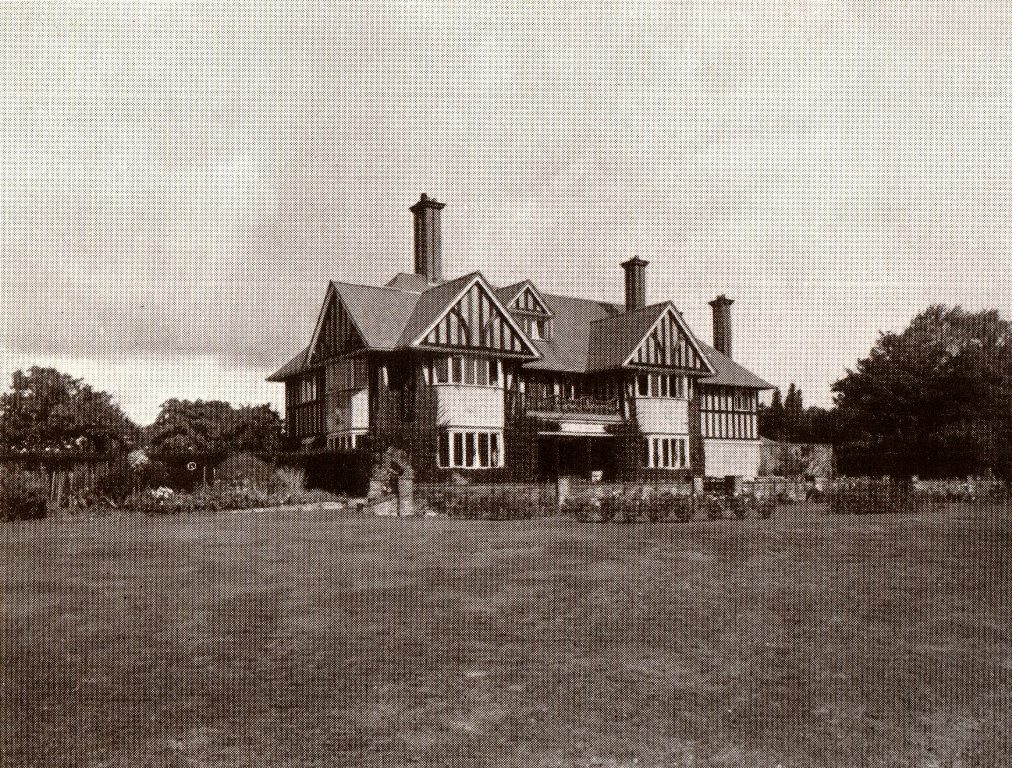
The Grange
The gardens were beautifully Landscaped with formal gardens, large ponds,an orchard and kitchen garden. During the First World War the house and grounds were requisitioned and Used by the Military as a convalescent home.
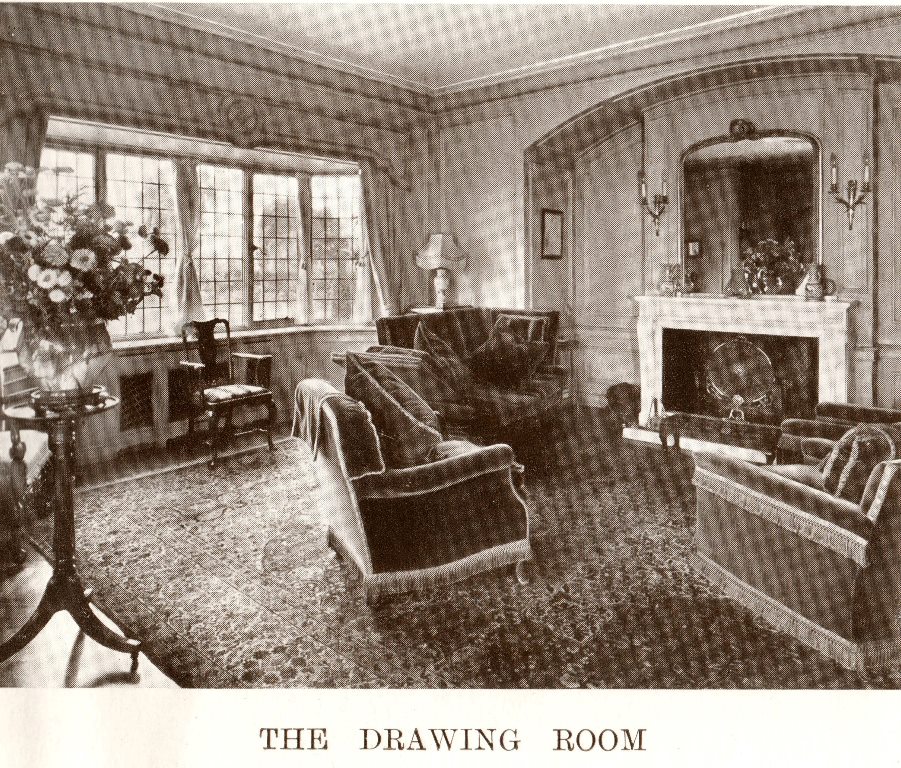
Drawing Room
The Grange was bought by Misses Lilley who carried out further landscaping; in 1939 the sisters sold the house and grounds to Essex county council.
In June 2003 the Harwich School announced its intention to sell the Grange and its grounds for redevelopment. The Grange is a listed building of special architectural or historic importance, thus conferring some protection on the building.
It was later to become a centre for further education as a sixth form college.
The Grange is a fine example of its period and is completely unaltered despite being over 100 years old.
Chase Lane School
The land for the school was acquired on the 28th of June 1960 and finally opened in 1968. It was originally planned to name the school the Cyril Moles County Primary School, after the chairman of the local education authority, but it was decided that using his name would look pompous. when Chase Lane School was built in 1968 on an open plan principle, it was described as a “revolution in the philosophy of education.”
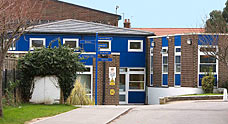
Chase Lane
It was built by the county council after a request by the then Ministry of Education to pioneer this “revolution.”
The building was designed to interpret the new education – free theory that the motivation for work should come from the child.
The Chase Lane Primary School was twenty one years old on September 1989, and its coming of age celebrations included as study on ‘The changing face of Dovercourt’. The School was divided into three units, each containing a set of three classes, and a different topic for each one.
Unit 1 (5s-6s Reception Infants and Middle Infants).
A study of Erlams shore and the leisure facilities – Warner’s, Caravan Site, the Pool. Their own homes and road safety.
Unit 2 (7s- 8s -9s- Top Infants and Lower Junior)
A study of farms food and mediaeval life to Modern day around the Green and the Pound Memorial, and their homes.
Unit 3 (Upper Juniors)
A study of All Saints Church, church cottages, the shops near the Memorial and their history. Transport, road systems and road names, open spaces, the churchyard, and land beside the new by-pass, and their homes, and why local families live in Dovercourt.
The School is still teaching children today.
Spring Meadows Primary School
The land for Spring Meadows Primary School was acquired on the 9th of April 1954. Spring Meadow is an attractively designed primary school first opened in 1979.
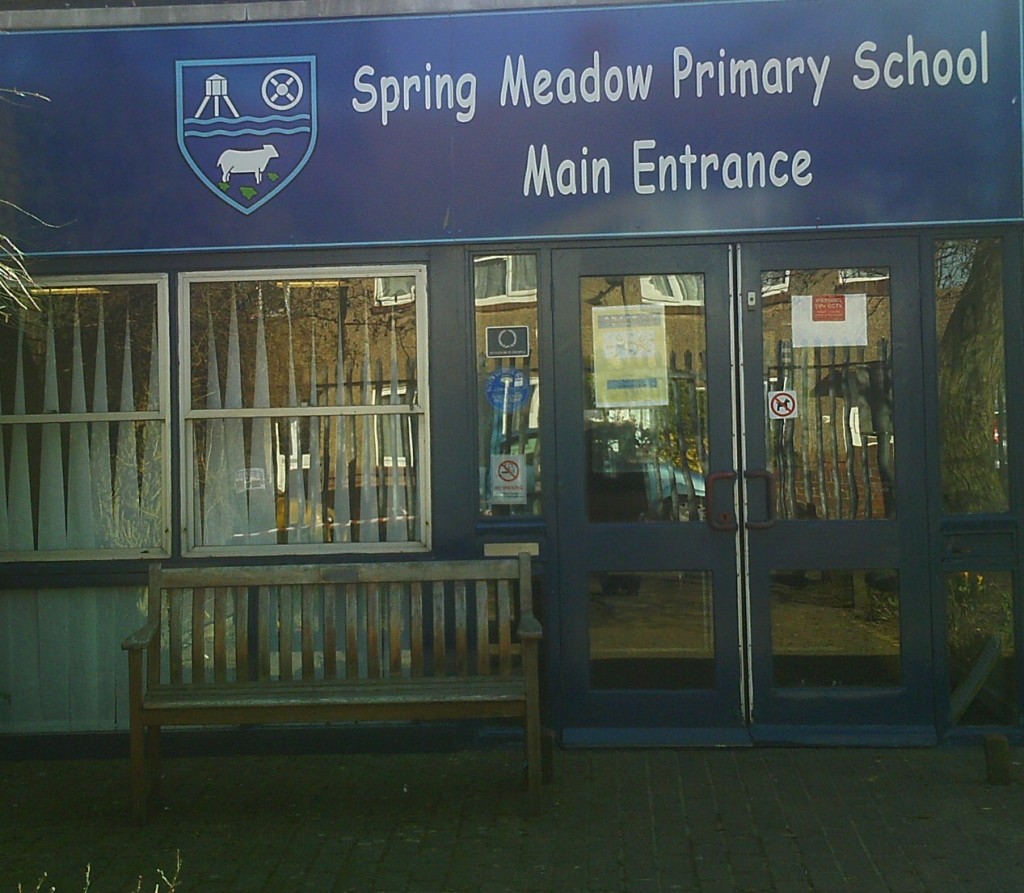
Spring Meadows
It was originally built with 7 classrooms but was later extended to its present size. The building is designed around a Central hall with twelve teaching areas, a multi-purpose area for Early Years children with an enclosed outside environment, purpose built computer suite, central library, medical room and administration Offices. The hall is a multi-purpose area providing the space for Physical Education, school Assemblies, plays and special productions, meetings and dining at lunchtime.
The teaching areas are arranged in pairs. Some are more open plan, others more enclosed. The Organisation of classes makes full use of the opportunity for children and staff to work collaboratively.
The school is still teaching children today.
Header photo by Philip Leather. “Hill School 1920’s”.
In those days we hated our school as it was responsible for our busy life. … Today these moments have become sweet memories of our life.
School Photo Album
The photos can also be viewed in full screen and as a slide show.
We hope you will enjoy browsing these wonderful photographs of The Schools,
- if you have a picture you would like included, please send your photos to info@harwichanddovercourt.co.uk
